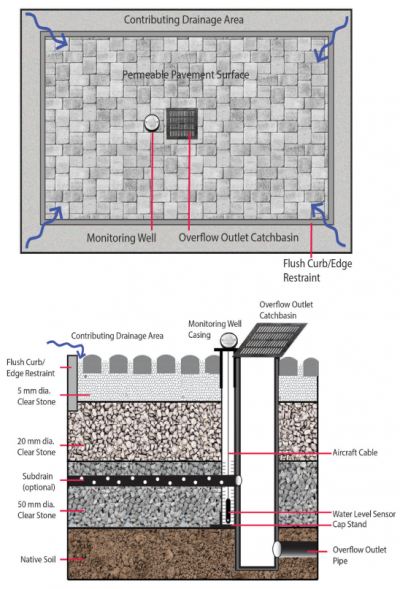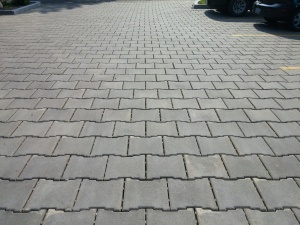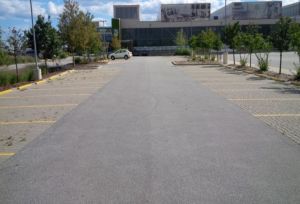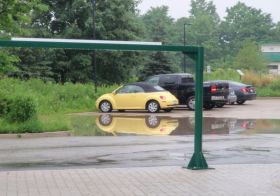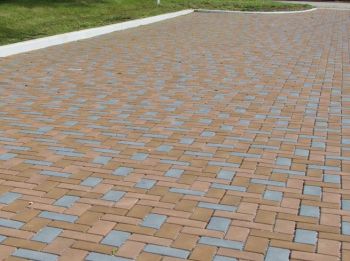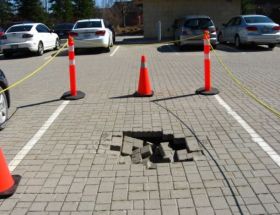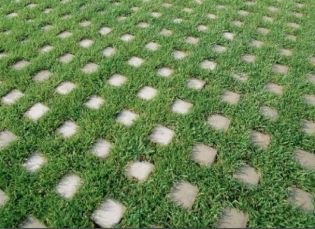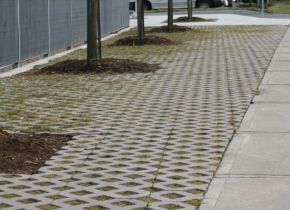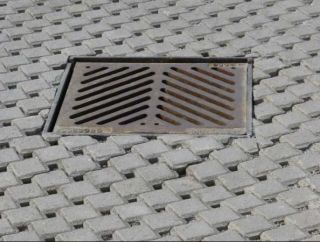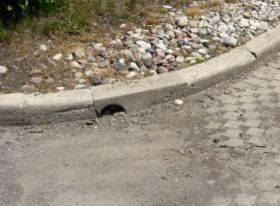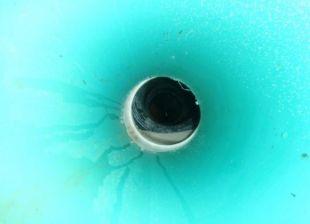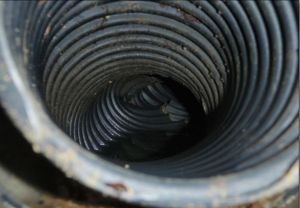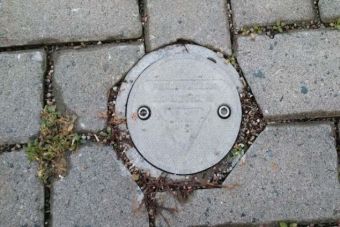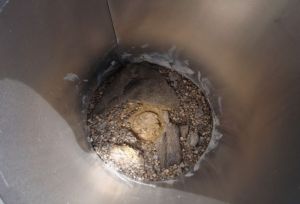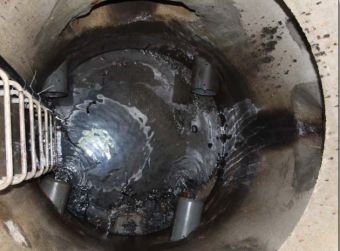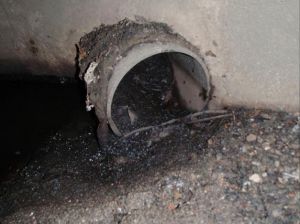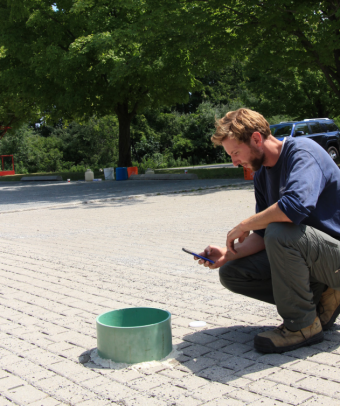Difference between revisions of "Inspection and Maintenance: Permeable Pavement"
| (30 intermediate revisions by the same user not shown) | |||
| Line 4: | Line 4: | ||
{{TOClimit|2}} | {{TOClimit|2}} | ||
==Overview== | ==Overview== | ||
[[Permeable pavements|Permeable Pavement]] Permeable pavements contain many small openings (i.e., joints or pores) that allow rainfall and snowmelt (i.e., stormwater) to drain through them instead of running off the surface as it does on impervious pavements like conventional asphalt and concrete. An overflow outlet is needed to safely convey flows during flood events. Depending on the permeability of the underlying soil and other constraints, the pavement may be designed with no sub-drain for full infiltration, with a sub-drain for partial infiltration, or with an impermeable liner and sub-drain for a no infiltration practice. The sub-drain pipe may feature a flow restrictor (e.g., orifice cap or valve) for gradually releasing detained water and optimizing the amount drained by [[infiltration]] into the underlying soil. | [[Permeable pavements|Permeable Pavement]] Permeable pavements contain many small openings (i.e., joints or pores) that allow rainfall and snowmelt (i.e., stormwater) to drain through them instead of running off the surface as it does on impervious pavements like conventional asphalt and concrete. An overflow outlet is needed to safely convey flows during flood events. Depending on the permeability of the underlying soil and other constraints, the pavement may be designed with no sub-drain for full infiltration, with a sub-drain for partial infiltration, or with an impermeable liner and sub-drain for a no infiltration practice. The sub-drain pipe may feature a flow restrictor (e.g., orifice cap or valve) for gradually releasing detained water and optimizing the amount drained by [[infiltration]] into the underlying soil. | ||
</br> | </br> | ||
[[File:P.p plan and profile view.PNG|thumb|400px|General plan and profile (cross-section) views showcasing key components and sections of a Permeable Interlocking Concerte Pavement (PICP).]] | |||
{{textbox|Key components of [[Permeable pavements]] to pay close attention to are the: | {{textbox|Key components of [[Permeable pavements]] to pay close attention to are the: | ||
| Line 25: | Line 26: | ||
==Inspection and Testing Framework== | ==Inspection and Testing Framework== | ||
[[File: | [[File:Articulatedblocksystem.png|thumb|300px|Permeable articulated block system at the LSRCA headquarters in Newmarket, ON is designed for heavy loads. This example shows an appropriate pavement surface condition when conducting any of, construction, assumption, routine or verification inspections.]] | ||
{| class="wikitable" style="width: 900px;" | {| class="wikitable" style="width: 900px;" | ||
|+'''Visual Indicators Framework - | |+'''Visual Indicators Framework - Permeable Pavements''' | ||
|- | |- | ||
!<br>'''Component''' | !<br>'''Component''' | ||
| Line 36: | Line 37: | ||
!<br>'''Verification Inspection''' | !<br>'''Verification Inspection''' | ||
|- | |- | ||
|rowspan="2"|'''[[ | |rowspan="2"|'''[[Permeable pavements: Sizing|Contributing Drainage Area]]''' | ||
|- | |- | ||
|CDA condition | |CDA condition | ||
| Line 44: | Line 45: | ||
|x | |x | ||
|- | |- | ||
|rowspan=" | |rowspan="2"|'''Perimeter''' | ||
|- | |- | ||
|BMP dimensions | |BMP dimensions | ||
| Line 78: | Line 53: | ||
|x | |x | ||
|- | |- | ||
|rowspan="3"|'''[[Aggregates|Filter Bed]]''' | |||
|rowspan=" | |||
|- | |- | ||
|Standing water | |Standing water | ||
| Line 104: | Line 67: | ||
| | | | ||
|- | |- | ||
| | |rowspan="4"|'''[[Vegetation]]''' | ||
| | |||
|- | |- | ||
| | |Vegetation cover | ||
|x | |x | ||
|x | |x | ||
| Line 116: | Line 75: | ||
|x | |x | ||
|- | |- | ||
| | |Vegetation condition | ||
| | | | ||
|x | |x | ||
|x | |x | ||
| | |||
|- | |||
|Vegetation composition | |||
|x | |x | ||
|x | |x | ||
|x | |x | ||
| | | | ||
|- | |||
|rowspan="3"|'''[[Underdrain]] & [[Wells|Monitoring Well]]''' | |||
|- | |||
|Monitoring well condition | |||
|x | |x | ||
|x | |x | ||
|x | |x | ||
|x | |x | ||
|- | |- | ||
| | |Sub-drain/Perforated pipe obstruction | ||
| | | | ||
|x | |x | ||
| | |||
|x | |x | ||
|- | |- | ||
|'''[[Overflow|Outlets]]''' | |||
| | |Overflow outlet obstruction | ||
|x | |x | ||
|x | |x | ||
| Line 148: | Line 108: | ||
|x | |x | ||
|- | |- | ||
| | |rowspan="5"|'''Pavement Surface''' | ||
|Pavement surface condition | |||
| | | | ||
|x | |x | ||
| Line 154: | Line 115: | ||
| | | | ||
|- | |- | ||
| | |Pavement surface sediment accumulation | ||
|x | |||
|x | |x | ||
|x | |x | ||
|x | |x | ||
|- | |- | ||
| | |Control structure condition | ||
|x | |x | ||
|x | |x | ||
| Line 168: | Line 127: | ||
|x | |x | ||
|- | |- | ||
| | |Control structure sediment accumulation | ||
|x | |x | ||
|x | |x | ||
| Line 182: | Line 135: | ||
|}<br> | |}<br> | ||
</br> | </br> | ||
[[File: | [[File:Sediment accumulation perm.JPG|thumb|300px|Permeable pavement in need of maintenance as excess sediment and unwanted vegetation growth has begun to occur near the perimeter of the installation. Source: (TRCA, 2016).<ref>STEP. 2018. Fact Sheet - Inspection and Maintenance of Stormwater Best Management Practices: Permeable Pavements. https://sustainabletechnologies.ca/app/uploads/2018/02/Permeable-Pavement-Fact-Sheet.pdf</ref>.]] | ||
{| class="wikitable" style="width: 900px;" | {| class="wikitable" style="width: 900px;" | ||
|+'''Testing Indicators Framework - | |+'''Testing Indicators Framework - Permeable Pavements''' | ||
|- | |- | ||
!<br>'''Component''' | !<br>'''Component''' | ||
| Line 194: | Line 147: | ||
!<br>'''Verification Inspection''' | !<br>'''Verification Inspection''' | ||
|- | |- | ||
|rowspan=" | |rowspan="4"|'''Testing Indicators''' | ||
|- | |- | ||
|Surface infiltration rate testing | |Surface infiltration rate testing | ||
| Line 229: | Line 170: | ||
|- | |- | ||
|} | |} | ||
==Construction Inspection Tasks== | |||
Construction inspections take place during several points in the construction sequence, specific to the type of LID BMP, but at a minimum should be done '''weekly''' and include the following: | |||
# During site preparation, prior to BMP excavation and grading to ensure the CDA is stabilized and/or flow diversion devices are in place and confirm that construction materials meet design specifications | |||
# At completion of excavation and grading, prior to backfilling and installation of pipes to ensure depths, slopes and elevations are acceptable | |||
# At completion of installation of pipes, prior to completion of backfilling to ensure slopes and elevations are acceptable | |||
# After final grading, prior to surface course installation to ensure depths, slopes and elevations are acceptable | |||
# Prior to hand-off points in the construction sequence when the contractor responsible for the work changes (i.e., hand-offs between the storm sewer servicing, paving, building and landscaping contractors) | |||
# After every large storm event (e.g., 15 mm rainfall depth or greater) to ensure flow diversion devices are functioning and adequately maintained. View the table below, which describes critical points during the construction sequence when inspections should be performed prior to proceeding further. You can also download and print the table [https://wikidev.sustainabletechnologies.ca/images/9/9f/LID-IM-Guide-7.4-Permeable-Pavements.pdf '''here''']<br> | |||
</br> | |||
[[File:MaintenancePICP.png|thumb|400px|A Vacuum Truck used for [[permeable pavement]] maintenance, which sucks up excess sediment and fines trapped between the pores of block pavers. Conducting this maintenance regularly helps maintain the practice's optimal infiltration rate during large rain events. (Source: STEP).]] | |||
{| class="wikitable" style="width: 800px;" | |||
|+'''Permeable Pavements: Construction Inspections''' | |||
|- | |||
!<br>'''Construction Sequence Step & Timing''' | |||
!<br>'''Inspection Item'''<br> | |||
!<br>'''<u><span title="Note for Observation Column: S = Satisfactory; U= Unsatisfactory; NA = Not Applicable ">Observations*</u>'''<br> | |||
|- | |||
|rowspan="6"|'''Site Preparation''' - after site clearing and grading, prior to BMP excavation and grading | |||
|Natural heritage system and tree protection areas remain fenced off | |||
| | |||
|- | |||
|ESCs protecting BMP layout area are installed properly | |||
| | |||
|- | |||
|CDA is stabilized or runoff is diverted around BMP layout area | |||
| | |||
|- | |||
|BMP layout area has been cleared and is staked/delineated | |||
| | |||
|- | |||
|Benchmark elevation(s) are established nearby | |||
| | |||
|- | |||
|Construction materials have been confirmed to meet design specifications | |||
| | |||
|- | |||
|rowspan="2"|'''BMP Excavation and Grading''' - prior to backfilling and installation of pipes/catchbasins | |||
|Excavated soil is stockpiled outside the CDA | |||
| | |||
|- | |||
|Excavation location, footprint, depth and slope are acceptable | |||
| | |||
|- | |||
|rowspan="6"|'''BMP Installation''' – after installation of pipes/catchbasins, prior to completion of backfilling | |||
|Structural components (e.g., pavement base, curbs) installation is acceptable | |||
| | |||
|- | |||
|Impermeable liner installed correctly, if applicable | |||
| | |||
|- | |||
|Installations of sub-drain pipes (e.g., locations, elevations, slopes), standpipes/monitoring wells are acceptable | |||
| | |||
|- | |||
|Sub-drain trench dams installed correctly (location, elevation) | |||
| | |||
|- | |||
|Surface coarse installation (elevation, slope, monitoring wells) is acceptable | |||
| | |||
|- | |||
|} | |||
==Routine Maintenance - Key Components and I&M Tasks== | |||
Regular inspections (twice annually, at a minimum) done as part of routine maintenance tasks over the operating phase of the BMP life cycle to determine if maintenance task frequencies are adequate and determine when rehabilitation or further investigations into BMP function are warranted. | |||
Table below describes routine maintenance tasks for [[permeable pavements]], organized by BMP component, along with recommended minimum frequencies. It also suggests higher frequencies for certain tasks that may be warranted for BMPs located in highly visible locations or those receiving flow from high traffic (vehicle or pedestrian) areas or those designed with higher than recommended impermeable drainage area to permeable BMP footprint area ratios ([[Notation|I:P ratios]]). Tasks involving removal of trash, debris and sediment and weeding/trimming of vegetation for BMPs in such contexts may need to be done more frequently (i.e., higher standards may be warranted). | |||
Individuals conducting [[vegetation]] maintenance and in particular, weeding (i.e., removal of undesirable vegetation), should be familiar with the species of [[Plant lists|plants]] specified in the planting plan and experienced in plant identification and methods of removing/controlling noxious weeds. Key resources on these topics are provided below at the links provided: | |||
*[http://www.weedinfo.ca/en/ Agriculture and Agri-food Canada’s Weed Info database] | |||
*[http://www.omafra.gov.on.ca/english/crops/facts/ontweeds/weedgal.htm Ontario Ministry of Agriculture, Food and Rural Affairs’ Ontario Weed Gallery] | |||
*[http://www.omafra.gov.on.ca/english/crops/facts/noxious_weeds.htm Ontario Ministry of Agriculture, Food and Rural Affairs’ Noxious Weeds In Ontario list] | |||
*[https://www.ontarioinvasiveplants.ca/wp-content/uploads/2016/07/QRG_FINAL.pdf Ontario Invasive Plant Council’s Quick Reference Guide to Invasive Plant Species] | |||
*[https://wrrc.arizona.edu/sites/wrrc.arizona.edu/files/OSU_Field%20Guide%20-%20Maintaining%20Rain%20Gardens%2C%20Swales%2C%20and%20Stormwater%20Planters.pdf Oregon State University Stormwater Solutions, 2013, Field Guide: Maintaining Rain Gardens, Swales and Stormwater Planters, Corvallis, OR.] | |||
*[https://lonepinebooks.com/product/plants-of-southern-ontario-2/ Plants of Southern Ontario (book), 2014, by Richard Dickinson and France Royer, Lone Pine Publishing, 528 pgs.] | |||
*[http://www.agrifs.ir/sites/default/files/Weeds%20of%20North%20America%20%7BRichard%20Dickinson%7D%20%5B9780226076447%5D%20%282014%29_2.pdf Weeds of North America (book), 2014, by Richard Dickinson and France Royer, University of Chicago Press, 656 pgs.] | |||
{|class="wikitable" style="width: 1280px" | |||
|+'''Permeable Pavements: Key Components, Descriptions and Routine I&M Requirements''' | |||
|- | |||
!style="width: 500px"|Comnponent | |||
!style="width: 1500px"|Description | |||
!style="width: 1500px"|Inspection & Maintenance Tasks | |||
!style="width: 500px"|<span style="color:green">('''Pass''')</span> Photo Example | |||
!style="width: 550px"|<span style="color:red">('''Fail''')</span> Photo Example | |||
|- | |||
|'''[[Permeable pavements: Sizing|Contributing Drainage Area (CDA)]]''' | |||
| | |||
Area(s) from which runoff directed to the BMP originates; includes the pavement itself and any adjacent impermeable pavement or roofs that drain to it. | |||
| | |||
*Remove trash, debris and sediment from pavements (biannually to quarterly) and eavestroughs (annually); | |||
*Replant or seed bare soil areas as needed. | |||
|[[File:CDA Pass p.p.JPG|300px|thumb|center|CDA has not changed in size or land cover. Sediment, trash or debris is not accumulating and point sources of contaminants are not visible.]] | |||
|[[File:CDA Fail p.p.JPG|280px|thumb|center|Size of the CDA has changed from design assumptions (i.e. large asphalt area drains to a small portion of the permeable pavement). Evidence of surface ponding is visible.]] | |||
|- | |||
|'''[[Pretreatment]]''' | |||
| | |||
Devices or features that retain trash, debris and sediment; help to extend the [[Cost analysis resources|operating life cycle]]; examples are eavestrough screens, [[Pretreatment|catch basin]] inserts and sumps, [[oil and grit separators]], [[inlets|geotextile-lined inlets]], [[Gravel diaphragms|gravel trenches]], [[Vegetated filter strips|grass filter strips]] and [[forebays]]. | |||
| | |||
*Remove trash, debris and sediment annually to biannually or when the device sump is half full; | |||
*Measure sediment depth or volume during each cleaning, or annually to estimate accumulation rate and optimize frequency of maintenance. | |||
|[[File:Pretreat Pass p.p.JPG|280px|thumb|center|Although permeable pavers are generally considered [[pretreatment]] for other BMPs in a [[Low impact development treatment train tool|treatment train]] system, using eavestrough screens can act as pretreatment as they don't add to sediment build up and accumulation on the paver surface. (Photo Source: Guertin, 2010)<ref>Guertin, M. 2010. Simple Screen Gutter Guards Better Than Pro-Installed Systems (and way cheaper). Fine Homebuilding - The Daily Fix. Accessed July 17 2022. https://www.finehomebuilding.com/2010/08/17/simple-screen-gutter-guards-better-than-pro-installed-systems-and-way-cheaper</ref>]] | |||
|[[File:Pretreat Fail p.p.JPG|300px|thumb|center|Build up of leads, sediment and leaf detritus in an eavestrough downspout disconnection leading to a permeable pavement surface. If not cleaned regularly this can lead to clogged pores between the pavers reducing the infiltration rate where the downspout deposits water onto the feature. (Photo Source: My Gutter Pro, 2021)<ref>My Gutter Pro. 2021. Clogged Downspout : Causes and Solutions. 10 April 2021. Accessed July 19 2022. https://mygutterpro.com/downspout-clog/</ref>]] | |||
|- | |||
|'''[[Inlets]]''' | |||
| | |||
Structures that deliver water to the BMP (e.g., impermeable pavement edges, [[pipes]] from roof downspouts or catchbasins). | |||
| | |||
*Keep free of obstructions; | |||
*Remove trash, debris and sediment biannually to quarterly; | |||
*Make note of sediment depth or volume during each cleaning or annually to estimate accumulation rate and optimize frequency of maintenance | |||
|[[File:Inlet Pass p.p.JPG|285px|thumb|center|Impermeable pavement edges along the edge of the pervious concrete and impermeable asphalt graded so excess sheet flow is infiltrated down through the pores of the infiltration BMP. (Photo Source: Fairfax County, 2014)<ref>Fairfax County. 2014. Protecting our Environment, one Stormwater Practice at a Time - Permeable Pavements. April 2014. Accessed: July 20 2022. https://www.fairfaxcounty.gov/publicworks/sites/publicworks/files/assets/documents/pdf/factsheets/permeable-pavement.pdf</ref>]] | |||
|[[File:Curb inlet grade.jpg|300px|thumb|center|Accumulated sediment, poor grading and vegetation is preventing stormwater from entering the [[swale]]. Sediment on the curb cut surface behind of the inlet indicates ponding is also occurring and is depositing water towards the permeable paver surface.]] | |||
|- | |||
|'''[[Permeable pavements: Specifications|Pavement Surface]]''' | |||
| | |||
The surface of the pavement, including pavers/pavement, joints and edge restraints (e.g., curbs, edging); should not allow water to pond on the surface so any observation or evidence of surface ponding (e.g., sediment caking on the pavement) indicates a drainage problem. | |||
| | |||
*Check for sediment, surface ponding, deformation, sink holes, damage and loss of joint fill; | |||
*Remove trash regularly (biannually-quarterly); | |||
*Grid systems with soil and grass fill are maintained like lawns; | |||
*Sweep and vacuum interlocking and rigid pavements regularly (annually-biannually) with regenerative air/pure vacuum sweeper; | |||
*Plow snow as needed and spread deicers sparingly during winter; | |||
*Repair ruts or local sinking of 15 mm or greater over a 3 metre length, adjacent pavers or cracks in pervious concrete or porous asphalt are vertically offset by 5 mm or greater and paver joint fill is missing or below 15 mm from the paver surface. | |||
|[[File:Pavesurface Pass p.p.JPG|350px|thumb|center|No damage, displacement or sinking of the permeable surface is visible and there are no weeds growing between paver joints.]] | |||
|[[File:Pavesurface Fail p.p.JPG|280px|thumb|center|The pavement surface has sunk in local areas, creating a trip hazard and the potential for further damage from snow plowing and parked vehicles nearby.]] | |||
|- | |||
|'''[[Vegetation]]''' | |||
| | |||
Applies to grid paver systems only; a mixture of deep rooting perennial grasses or low growing ground covers, tolerant to both wet and dry conditions and salt (if receiving impermeable pavement runoff); roots uptake water and return it to the atmosphere, provide habitat for soil organisms that break down pollutants trapped in the soil and help maintain soil structure and permeability. | |||
| | |||
*Grid systems with soil and grass fill are maintained like lawns; | |||
*In the first 2 months water frequently (biweekly in the absence or rain) and as needed (e.g., bimonthly) over the remainder of the first growing season; | |||
*Remove weeds and undesirable plants biannually to quarterly; | |||
*Replace/reseed dead plantings annually to achieve 80% cover by the third growing season; | |||
*Do not apply chemical fertilizers. | |||
|[[File:Veg Pass p.p.JPG|315px|thumb|center|The vegetation cover on the permeable pavement is turf grass as specified in the final design and contains very few weeds. (Photo source: WEF).]] | |||
|[[File:Veg Fail p.p.JPG|290px|thumb|center|The turf grass cover on the permeable walkway is not thriving in some areas and needs cutting in others. It is also impairing the aesthetic value of the BMP.]] | |||
|- | |||
|'''[[Overflow|Overflow Outlet]]''' | |||
| | |||
Structures (e.g., catchbasin, curb-cut, [[swale]]) that convey flow that exceeds the storage capacity of the BMP to another drainage system (e.g., municipal storm sewer or other BMP). | |||
| | |||
*Keep free of obstructions; | |||
*Remove trash, debris and sediment biannually to quarterly. | |||
|[[File:Overflow Pass p.p.JPG|320px|thumb|center|The overflow outlet is free of damage and obstruction and functions as designed to safely convey excess water from the BMP.]] | |||
|[[File:Overflow Fail p.p.JPG|280px|thumb|center|The overflow outlet is obstructed with sediment which impairs its function to convey excess water from the BMP.]] | |||
|- | |||
|'''[[Underdrain|Sub-drain]]''' | |||
| | |||
Optional component; [[Pipes|perforated pipe(s)]] surrounded by [[gravel]] and may be wrapped in [[Geotextile|geotextile filter fabric]]; installed in the base or sub-base gravel layer to collect and convey treated water to an adjacent drainage system or other BMP; may also include a flow restrictor. | |||
| | |||
*Keep pipe and flow restrictor free of obstructions by flushing annually; | |||
*Inspect flow restrictor regularly (e.g., biannually to quarterly). | |||
|[[File:Underdrain Pass p.p.JPG|310px|thumb|center|The solid section of the sub-drain pipe is not obstructed by sediment, debris or roots and shows no signs of damage.]] | |||
|[[File:Underdrain Fail p.p.JPG|300px|thumb|center|A section of the sub-drain pipe has been crushed which substantially reduces its conveyance capacity]] | |||
|- | |||
|'''[[Monitoring well]]''' | |||
| | |||
[[Wells|Perforated standpipe]] that extends from the bottom of the excavation to just below the pavement surface and contains perforations or slots to allow [[Digital technologies|measurement of subsurface water level]]; used to track drainage performance over the operating life cycle of the BMP. | |||
| | |||
*[[Wells|Standpipes]] should be securely capped on both ends and protected from damage by vehicular traffic by a casing. | |||
|[[File:Monitor Pass p.p.JPG|340px|thumb|center|The well is undamaged and accessible and the cap is in place and secured to prevent unauthorized access]] | |||
|[[File:Monitor Fail p.p.JPG|300px|thumb|center|The well cap is missing and the casing is clogged by sediment, preventing access for monitoring and allowing sediment to flow into the sub-drain system.]] | |||
|- | |||
|'''[[Flow through riser|Control Structure]]''' | |||
| | |||
Manhole or catchbasin to which the subdrain outlets that provides access to the [[underdrain]] and flow restrictor. Inspect for accessibility, damage and sediment. | |||
| | |||
*Remove trash, debris and sediment regularly (biannually/quarterly).. | |||
|[[File:Control Struct Pass p.p.JPG|340px|thumb|center|TThere is some sediment accumulated in the manhole but it is not impairing the flow of stormwater into or out of the BMP. (Photo source: SWC Canada)]] | |||
|[[File:Control Struct Fail p.p.JPG|300px|thumb|center|The manhole sump is full of sediment and debris and it is beginning to impair flow of stormwater into a perforated pipe of the exfiltration storm sewer system.]] | |||
|} | |||
==Tips to Preserve Basic BMP Function== | |||
*Never use sealants on porous asphalt nor pervious concrete. | |||
*Prohibit access by [[construction]] vehicles to prevent tracking of sediment on to the surface. | |||
*Prohibit storage of [[Soil groups|soil]], [[compost]], [[sand]], [[salt]] or unwashed [[gravel]] on permeable pavements to prevent clogging of joints or pores, or protect the pavement surface with tarps or [[geotextile]] during temporary storage of such materials. | |||
*Landscaped areas adjacent to permeable pavements should be covered with [[vegetation]] and not drain to the pavement where possible to prevent eroding [[Soil groups|soil]] from reaching the surface. | |||
*Use a mulching mower to mow permeable interlocking grid systems with [[grasses|grass]] cover. | |||
*Permeable pavements can be [[Winter|plowed]] for snow removal like conventional pavements. To reduce the risk of dislodging pavers or grids and minimize displacement of joint/cell fill material, the plow blade should be slightly raised off the pavement surface (e.g., 0.6 cm or 1/4”) with a shoe attachment. | |||
*Plowed snow piles should not be stored on permeable pavements to reduce the risk of [[clogging]] from sediment accumulation upon melting. | |||
*Do not spread [[sand]] on permeable pavements as part of [[Winter|winter maintenance]] as it will quickly clog the joints or pores and impair drainage function. On permeable interlocking pavers and grid systems filled with gravel, if application of an anti-skid material is desirable, spread the same fine washed gravel material used to fill the paver joints or grid cells; and | |||
*[[Salt|De-icers]] should be used sparingly, as needed during winter. Due to their freely draining design, ice will not form on permeable pavements as readily as it does on conventional impermeable pavements during winter thaw-freeze cycles. | |||
==Rehabilitation & Repair== | |||
Table below provides guidance on rehabilitation and repair work specific to permeable pavements organized according to BMP component. | |||
[[File:Lifting paver to clean.JPG|thumb|340px|Removing a section of pavers (where infiltration has decreased markedly, or all pavers (if necessary) should occur if surface drainage performance remains unacceptable. Joint fill and bedding layer will need be replaced at this point with new materials to help obtain initial design specifications (Photo Source: Western Interlock Inc., 2020)<ref>Western Interlock Inc. 2020.How to Remove Pavers and Replace Them. Repair & Maintenance. Authored June 2020. Accessed: 21 July 2022. https://westerninterlock.com/how-to-remove-and-replace-a-paver/</ref>]] | |||
{|{| class="wikitable" style="width: 900px;" | |||
|+'''Permeable Pavements: Key Components, Typical Issues and Rehabilitation Requirements''' | |||
|- | |||
!Component | |||
!Problem | |||
!Rehabilitation Tasks | |||
|- | |||
| rowspan="3"|'''[[Permeable pavements: Specifications|Pavement Surface]]''' | |||
|Major cracks, spalling or raveling of the porous asphalt or pervious concrete surface | |||
| | |||
*Fill small potholes or cracks with patching mixes (consult with product vendor for further guidance). Large potholes or cracks may require cutting and replacement of a section of the surface layer. Replace with the same permeable material where possible. Conventional asphalt or concrete could be acceptable if the cumulative area remains below 15% of the total BMP footprint area. | |||
|- | |||
|Paver or grid unit is missing, damaged or displaced | |||
| | |||
*Replace or reset unit by hand and restore joint or grid cell fill material that meets design specification. | |||
|- | |||
|Surface [[infiltration]] rate is < 250 mm/h | |||
| | |||
*Sweep and thoroughly vacuum with a pure vacuum sweeper to remove accumulated sediment. Replace [[OPSS aggregates|joint fill material]] removed through vacuuming. Pretreatment of the surface of slow draining pavements (e.g., water-assisted techniques, additional sweeping) prior to vacuuming may be warranted where surface [[clogging]] of joints or pores is visible. If surface drainage performance remains unacceptable, remove all pavers, [[Choker layer|bedding]] and joint fill and top 5 cm (2”) of base [[Reservoir aggregate|aggregate]] and replace with new materials that meet design specifications. | |||
|- | |||
|'''[[Vegetation]]''' | |||
| | |||
Poor grass cover on interlocking permeable grid system | |||
| | |||
*Aerate or remove and replace growing medium in affected area with material that meets design specifications and replant. | |||
|- | |||
|'''[[Underdrain|Sub-drain]]''' | |||
| | |||
Sub-drain perforated pipe is obstructed by sediment. | |||
| | |||
*Schedule [[Permeable pavements: Maintenance|hydro-vac truck]] or drain-snaking service to remove the obstruction. | |||
|} | |||
==Inspection Time Commitments and Costs== | |||
Estimates are based on a typical partial infiltration permeable pavement design (i.e., includes a sub-drain); estimates for other designs (i.e., full infiltration and no-infiltration) are described in | |||
the [https://sustainabletechnologies.ca/app/uploads/2016/08/LID-IM-Guide-7.4-Permeable-Pavements.pdf Low Impact Development (LID) Stormwater Management Practice Inspection and Maintenance Guide]<br> | |||
</br> | |||
[[File:Task cost estimates p.p.JPG|thumb|left|400px|Per-task cost estimates for maintenance and rehabilitation of a partial infiltration permeable pavement LID feature (in 2016 $ figures).<ref>TRCA. 2018. Inspection and Maintenance of Stormwater Best Management Practices. Permeable Pavements - Fact Sheet. https://sustainabletechnologies.ca/app/uploads/2018/02/Permeable-Pavement-Fact-Sheet.pdf</ref>]] | |||
[[File:Maintenance & operation p.p.JPG|thumb|400px|General time commitments and costs for inspection of permeable pavement features with partial infiltration design (in 2016 $ figures).<ref>TRCA. 2018. Inspection and Maintenance of Stormwater Best Management Practices. Permeable Pavements - Fact Sheet. https://sustainabletechnologies.ca/app/uploads/2018/02/Permeable-Pavement-Fact-Sheet.pdf</ref>]] | |||
[[File:Life cycle estimate p.p.JPG|thumb|center|400px|Construction and life cycle cost estimates for permeable pavement features with partial infiltration design (in 2016 $ figures).<ref>TRCA. 2018. Inspection and Maintenance of Stormwater Best Management Practices. Permeable Pavements- Fact Sheet. https://sustainabletechnologies.ca/app/uploads/2018/02/Permeable-Pavement-Fact-Sheet.pdf</ref>]]<br> | |||
Estimates of the life cycle costs of inspection and maintenance have been produced using the latest version of the [[Cost analysis resources|LID Life Cycle Costing Tool]] for three design variations (full infiltration, partial infiltration and no infiltration) to assist stormwater infrastructure planners, designers and asset managers with planning and preparing budgets for potential LID features. | |||
Assumptions for the above costs and the following table below are based on the following: | |||
*Design variations for permeable pavements can be broken down into three main categories: | |||
**Full Infiltration design, where the pavement drains through infiltration into the underlying subsoil alone (i.e., no sub-drain); | |||
**Partial Infiltration design, where drainage is through the combination of a subdrain and infiltration into the underlying subsoil (i.e., with a sub-drain); or, | |||
**No Infiltration (i.e., filtration only design) that includes an impermeable liner between the base of the BMP and the underlying native sub-soil, where drainage is through a sub-drain alone (i.e., with a sub-drain and impermeable liner). | |||
*For permeable pavements it is assumed that rehabilitation of the pavement surface will be needed once the BMP reaches 30 years of age in order to maintain surface drainage performance at an acceptable level. Included in the rehabilitation costs are (de)mobilization costs, as equipment would not have been present on site. | |||
*Design costs were not included in the rehabilitation as it was assumed that the original LID practice design would be used to inform this work. The annual average maintenance cost does not include rehabilitation costs and therefore represents an average of routine maintenance tasks, as outlined in Table Permeable Pavements: Key Components, Descriptions and Routine I&M Requirements, above. All cost value estimates represent the NPV as the calculation takes into account average annual interest (2%) and discount (3%) rates over the evaluation time periods. | |||
*The costing presented in this section is specific to permeable interlocking concrete pavers (PICP), as defined in the Tool. This product has been selected for costing due to its popularity and well understood maintenance needs. | |||
*For all permeable pavement design variations, the CDA has been defined as 2,000 m<sup>2</sup> of which 1,000 m<sup>2</sup> is impermeable pavement draining to the pavers, and 1,000 m<sup>2</sup> is permeable pavement. The impervious area to pervious area ratio (I:P ratio) used to size the BMP footprint is 1:1, which is in accordance with recommendations in the [https://sustainabletechnologies.ca/app/uploads/2013/01/LID-SWM-Guide-v1.0_2010_1_no-appendices.pdf LID SWM Planning and Design Guide (CVC & TRCA, 2010)]. | |||
**The Full Infiltration design does not include a sub-drain and assumes a native sub-soil infiltration rate of 20 mm/h. The base granular reservoir is 350 mm deep and is capable of storing runoff from a 61 mm rain event over the CDA. A monitoring well is included for inspection purposes. | |||
**The Partial Infiltration design includes a sub-drain and assumes a native sub-soil infiltration rate of 10 mm/h. The base granular reservoir is 350 mm deep and is capable of storing runoff from a 9 mm rain event before the stored volume reaches the perforated underdrain pipe located 50 mm above the native sub-soil. Although a flow restrictor is recommended to maximize infiltration, the cost of this feature is not included due to its relatively low cost. | |||
**The No Infiltration design includes a sub-drain pipe installed on the bottom of the sub-surface water storage reservoir and an impermeable liner. All other features are the same as the Partial Infiltration design variation. | |||
*Estimates of the life cycle costs of PICP permeable pavements in Canadian dollars per unit CDA ($/m<sup>2</sup>) are presented in the table below. [[Cost analysis resources|LID Life Cycle Costing Tool]] allows users to select what BMP type and design variation applies, and to use the default assumptions to generate planning level cost estimates. | |||
**Users can also input their own values relating to a site or area, design, unit costs, and inspection and maintenance task frequencies to generate customized cost estimates, specific to a certain project, context or stormwater infrastructure program. | |||
**For all BMP design variations and maintenance scenarios, it is assumed that rehabilitation of the pavement surface will be necessary when the BMP reaches 30 years of age to maintain acceptable surface drainage performance. Rehabilitation of PICP pavements is assumed to typically involve the following tasks and associated costs: | |||
***Remove pavers, bedding and joint fill and top 5 cm (2”) of base aggregate and replace with new material that meets design specifications | |||
***Construction and Assumption inspection and testing associated with rehabilitation work to confirm that materials meet design specifications and installation is acceptable, including compaction and surface infiltration rate testing. <br> | |||
</br> | |||
[[File:Minimum & hig hfreq cost p.p.PNG|thumb|center|900px|Life cycle cost estimates for all infiltration types of PICP [[permeable pavements]] an under minimum and high frequency scenarios (in 2016 $ figures).<ref>TRCA. 2016. Low Impact Development Stormwater Management Practice Inspection and Maintenance Guide. Prepared by the Sustainable Technologies Evaluation Program. Vaughan, Ontario. https://sustainabletechnologies.ca/app/uploads/2016/08/LID-IM-Guide-7.4-Permeable-Pavements.pdf</ref>]] | |||
'''Notes:''' | |||
<small> | |||
#Estimated life cycle costs represent NPV of associated costs in Canadian dollars per square metre of CDA ($/m2). | |||
#Average annual maintenance cost estimates represent NPV of all costs incurred over the time period and do not include rehabilitation costs. | |||
#Rehabilitation cost estimates represent NPV of all costs related to rehabilitative maintenance work assumed to be needed after 30 years in service, including those associated with inspection. | |||
#Full Infiltration design life cycle costs are lower than Partial and No Infiltration designs due to the absence of a sub-drain to construct, inspect and routinely flush. | |||
#Rehabilitation costs for Full Infiltration designs are estimated to be 54.8% to 55.6% of the original construction costs for High and Minimum Recommended Frequency maintenance program scenarios, respectively. | |||
#Rehabilitation costs for Partial Infiltration designs are estimated to be 53.5% to 54.3% of the original construction costs for High and Minimum Recommended Frequency maintenance program scenarios, respectively. | |||
#Rehabilitation costs for No Infiltration designs are estimated to be 47.4% to 48.1% of the original construction costs for High and Minimum Recommended Frequency maintenance program scenarios, respectively. | |||
#Maintenance and rehabilitation costs over a 25 year time period for the Minimum Recommended maintenance scenario are estimated to be 22.3%, of the original construction costs for Full Infiltration design, 22.6% for Partial Infiltration design, and 20.0% for No Infiltration design. | |||
#Maintenance and rehabilitation costs over a 25 year time period for the High Frequency maintenance scenario are estimated to be: 39.0% of the original construction costs for Full, 38.9% for Partial Infiltration designs, and 34.5% for No Infiltration designs. | |||
#Maintenance and rehabilitation costs over a 50 year time period for the Minimum Recommended Frequency maintenance scenario are estimated to be approximately: 1.07 times the original construction cost for Full, 1.06 times the original construction costs for Partial Infiltration designs, and 93.9.% the original construction cost for No Infiltration designs. | |||
#Maintenance and rehabilitation costs over a 50 year time period for the High Frequency maintenance scenario are estimated to be approximately: 1.43 times the original construction cost for Full, 1.41 times the original construction costs for Partial Infiltration designs, and 1.25 times the original construction cost for No Infiltration designs. | |||
</small> | |||
==Inspection Field Data Sheet== | |||
Feel free to '''download''' (downward facing arrow on the top righthand side) and '''print''' (Pinter emoticon on top right hand side) the following [[Permeable pavements]] Inspection Field Data Form developed by TRCA, STEP and its partners for the [https://sustainabletechnologies.ca/app/uploads/2016/08/LID-IM-Guide-2016-1.pdf Low Impact Development Stormwater Management Practice Inspection and Maintenance Guide]<ref>STEP. 2016. Low Impact Development Stormwater Management Practice Inspection and Maintenance Guide. https://sustainabletechnologies.ca/app/uploads/2016/08/LID-IM-Guide-2016-1.pdf</ref>. | |||
The 4 page document prompts users to fill out details previously mentioned above on this page in other sections about various zones associated with [[[Permeable pavements]] features (i.e. CDA, pavement surface, associated control structures, outlets, etc.) and describe why each area is a pass or fail, and if remediate action is required and under what timeframe it would be completed by. Furthermore, the forms prompt the reviewer to determine what type of inspection is being conducted for the feature in question: Construction (C), Routine Operation (RO), Maintenance Verification (MV), or Performance Verification (PV). <br> | |||
<br> | |||
[[File:Single ring infilt p.p.PNG|thumb|340px|Surface infiltration testing conducted with a simple single-ring infiltrometer and a timer on the technician's mobile phone.]] | |||
<pdf width="900" height="800">File:Permeable Pavements inspection sheet.pdf</pdf> | |||
==References== | |||
Latest revision as of 15:09, 11 August 2022
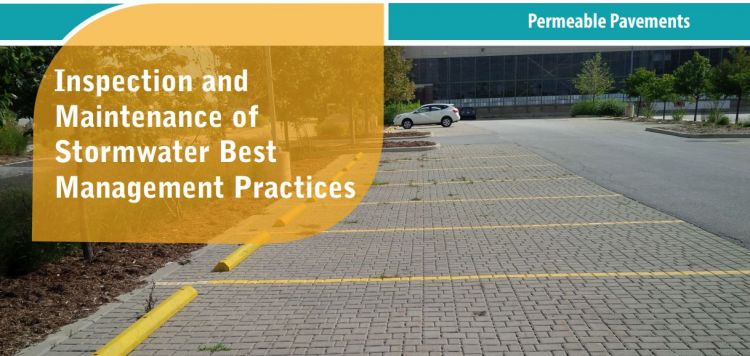
Overview[edit]
Permeable Pavement Permeable pavements contain many small openings (i.e., joints or pores) that allow rainfall and snowmelt (i.e., stormwater) to drain through them instead of running off the surface as it does on impervious pavements like conventional asphalt and concrete. An overflow outlet is needed to safely convey flows during flood events. Depending on the permeability of the underlying soil and other constraints, the pavement may be designed with no sub-drain for full infiltration, with a sub-drain for partial infiltration, or with an impermeable liner and sub-drain for a no infiltration practice. The sub-drain pipe may feature a flow restrictor (e.g., orifice cap or valve) for gradually releasing detained water and optimizing the amount drained by infiltration into the underlying soil.
Key components of Permeable pavements to pay close attention to are the:
Associated Practices[edit]
- Permeable Interlocking Pavers (i.e., Block Pavers) – Precast modular units made of concrete, pervious concrete or rubber/plastic composite designed to create open joints between pavers that are filled with fine, washed aggregate and installed on an open graded aggregate (i.e., clear stone) base and sub-base.
- Permeable Interlocking Grid Systems (i.e., grid pavers) – Precast concrete or manufactured plastic grids with open cells that can be filled with aggregate or a mixture of sand, gravel and topsoil and planted with grass or low-growing ground covers and are installed on an open-graded aggregate base.
- Pervious Concrete – a rigid pavement installed on an open-graded aggregate base that uses a cementitious binder to adhere aggregate together, similar to conventional concrete, except that the fine aggregate component is minimized or eliminated which results in the formation of connected pores throughout.
- Porous Asphalt – a flexible pavement installed on an open-graded aggregate base that uses a bituminous binder to adhere aggregate together, similar to conventional asphalt, except that the fine aggregate component is minimized or eliminated which results in the formation of connected pores throughout.
Inspection and Testing Framework[edit]
Component |
Indicators |
Construction Inspection |
Assumption Inspection |
Routine Operation Inspection |
Verification Inspection |
|---|---|---|---|---|---|
| Contributing Drainage Area | |||||
| CDA condition | x | x | x | x | |
| Perimeter | |||||
| BMP dimensions | x | x | x | ||
| Filter Bed | |||||
| Standing water | x | x | x | ||
| Trash | x | x | |||
| Vegetation | |||||
| Vegetation cover | x | x | x | x | |
| Vegetation condition | x | x | |||
| Vegetation composition | x | x | x | ||
| Underdrain & Monitoring Well | |||||
| Monitoring well condition | x | x | x | x | |
| Sub-drain/Perforated pipe obstruction | x | x | |||
| Outlets | Overflow outlet obstruction | x | x | x | x |
| Pavement Surface | Pavement surface condition | x | x | ||
| Pavement surface sediment accumulation | x | x | x | x | |
| Control structure condition | x | x | x | x | |
| Control structure sediment accumulation | x | x | x | x |
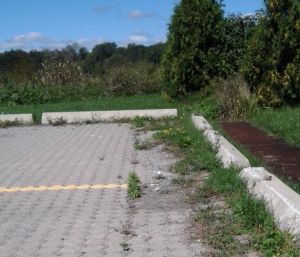
Component |
Indicators |
Construction Inspection |
Assumption Inspection |
Routine Operation Inspection |
Verification Inspection | |
|---|---|---|---|---|---|---|
| Testing Indicators | ||||||
| Surface infiltration rate testing | x | (x) | ||||
| Natural or simulated storm event testing | x | (x) | ||||
| Continuous monitoring | x | (x) | ||||
| Note: (x) denotes indicators to be used for Performance Verification inspections only (i.e., not for Maintenance Verification inspections) | ||||||
Construction Inspection Tasks[edit]
Construction inspections take place during several points in the construction sequence, specific to the type of LID BMP, but at a minimum should be done weekly and include the following:
- During site preparation, prior to BMP excavation and grading to ensure the CDA is stabilized and/or flow diversion devices are in place and confirm that construction materials meet design specifications
- At completion of excavation and grading, prior to backfilling and installation of pipes to ensure depths, slopes and elevations are acceptable
- At completion of installation of pipes, prior to completion of backfilling to ensure slopes and elevations are acceptable
- After final grading, prior to surface course installation to ensure depths, slopes and elevations are acceptable
- Prior to hand-off points in the construction sequence when the contractor responsible for the work changes (i.e., hand-offs between the storm sewer servicing, paving, building and landscaping contractors)
- After every large storm event (e.g., 15 mm rainfall depth or greater) to ensure flow diversion devices are functioning and adequately maintained. View the table below, which describes critical points during the construction sequence when inspections should be performed prior to proceeding further. You can also download and print the table here
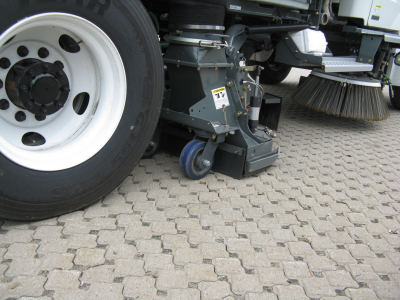
Construction Sequence Step & Timing |
Inspection Item |
Observations* |
|---|---|---|
| Site Preparation - after site clearing and grading, prior to BMP excavation and grading | Natural heritage system and tree protection areas remain fenced off | |
| ESCs protecting BMP layout area are installed properly | ||
| CDA is stabilized or runoff is diverted around BMP layout area | ||
| BMP layout area has been cleared and is staked/delineated | ||
| Benchmark elevation(s) are established nearby | ||
| Construction materials have been confirmed to meet design specifications | ||
| BMP Excavation and Grading - prior to backfilling and installation of pipes/catchbasins | Excavated soil is stockpiled outside the CDA | |
| Excavation location, footprint, depth and slope are acceptable | ||
| BMP Installation – after installation of pipes/catchbasins, prior to completion of backfilling | Structural components (e.g., pavement base, curbs) installation is acceptable | |
| Impermeable liner installed correctly, if applicable | ||
| Installations of sub-drain pipes (e.g., locations, elevations, slopes), standpipes/monitoring wells are acceptable | ||
| Sub-drain trench dams installed correctly (location, elevation) | ||
| Surface coarse installation (elevation, slope, monitoring wells) is acceptable |
Routine Maintenance - Key Components and I&M Tasks[edit]
Regular inspections (twice annually, at a minimum) done as part of routine maintenance tasks over the operating phase of the BMP life cycle to determine if maintenance task frequencies are adequate and determine when rehabilitation or further investigations into BMP function are warranted.
Table below describes routine maintenance tasks for permeable pavements, organized by BMP component, along with recommended minimum frequencies. It also suggests higher frequencies for certain tasks that may be warranted for BMPs located in highly visible locations or those receiving flow from high traffic (vehicle or pedestrian) areas or those designed with higher than recommended impermeable drainage area to permeable BMP footprint area ratios (I:P ratios). Tasks involving removal of trash, debris and sediment and weeding/trimming of vegetation for BMPs in such contexts may need to be done more frequently (i.e., higher standards may be warranted).
Individuals conducting vegetation maintenance and in particular, weeding (i.e., removal of undesirable vegetation), should be familiar with the species of plants specified in the planting plan and experienced in plant identification and methods of removing/controlling noxious weeds. Key resources on these topics are provided below at the links provided:
- Agriculture and Agri-food Canada’s Weed Info database
- Ontario Ministry of Agriculture, Food and Rural Affairs’ Ontario Weed Gallery
- Ontario Ministry of Agriculture, Food and Rural Affairs’ Noxious Weeds In Ontario list
- Ontario Invasive Plant Council’s Quick Reference Guide to Invasive Plant Species
- Oregon State University Stormwater Solutions, 2013, Field Guide: Maintaining Rain Gardens, Swales and Stormwater Planters, Corvallis, OR.
- Plants of Southern Ontario (book), 2014, by Richard Dickinson and France Royer, Lone Pine Publishing, 528 pgs.
- Weeds of North America (book), 2014, by Richard Dickinson and France Royer, University of Chicago Press, 656 pgs.
| Comnponent | Description | Inspection & Maintenance Tasks | (Pass) Photo Example | (Fail) Photo Example |
|---|---|---|---|---|
| Contributing Drainage Area (CDA) |
Area(s) from which runoff directed to the BMP originates; includes the pavement itself and any adjacent impermeable pavement or roofs that drain to it. |
|
||
| Pretreatment |
Devices or features that retain trash, debris and sediment; help to extend the operating life cycle; examples are eavestrough screens, catch basin inserts and sumps, oil and grit separators, geotextile-lined inlets, gravel trenches, grass filter strips and forebays. |
|
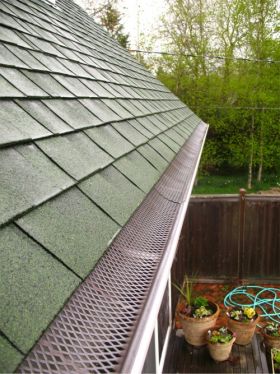 Although permeable pavers are generally considered pretreatment for other BMPs in a treatment train system, using eavestrough screens can act as pretreatment as they don't add to sediment build up and accumulation on the paver surface. (Photo Source: Guertin, 2010)[3] |
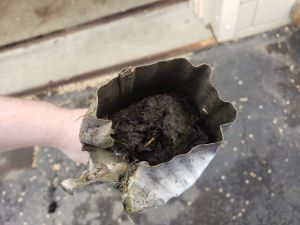 Build up of leads, sediment and leaf detritus in an eavestrough downspout disconnection leading to a permeable pavement surface. If not cleaned regularly this can lead to clogged pores between the pavers reducing the infiltration rate where the downspout deposits water onto the feature. (Photo Source: My Gutter Pro, 2021)[4] |
| Inlets |
Structures that deliver water to the BMP (e.g., impermeable pavement edges, pipes from roof downspouts or catchbasins). |
|
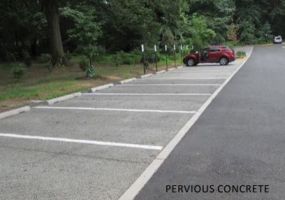 Impermeable pavement edges along the edge of the pervious concrete and impermeable asphalt graded so excess sheet flow is infiltrated down through the pores of the infiltration BMP. (Photo Source: Fairfax County, 2014)[5] |
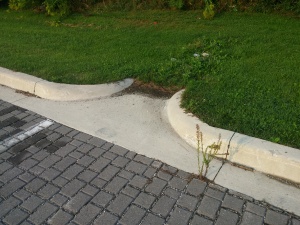 Accumulated sediment, poor grading and vegetation is preventing stormwater from entering the swale. Sediment on the curb cut surface behind of the inlet indicates ponding is also occurring and is depositing water towards the permeable paver surface. |
| Pavement Surface |
The surface of the pavement, including pavers/pavement, joints and edge restraints (e.g., curbs, edging); should not allow water to pond on the surface so any observation or evidence of surface ponding (e.g., sediment caking on the pavement) indicates a drainage problem. |
|
||
| Vegetation |
Applies to grid paver systems only; a mixture of deep rooting perennial grasses or low growing ground covers, tolerant to both wet and dry conditions and salt (if receiving impermeable pavement runoff); roots uptake water and return it to the atmosphere, provide habitat for soil organisms that break down pollutants trapped in the soil and help maintain soil structure and permeability. |
|
||
| Overflow Outlet |
Structures (e.g., catchbasin, curb-cut, swale) that convey flow that exceeds the storage capacity of the BMP to another drainage system (e.g., municipal storm sewer or other BMP). |
|
||
| Sub-drain |
Optional component; perforated pipe(s) surrounded by gravel and may be wrapped in geotextile filter fabric; installed in the base or sub-base gravel layer to collect and convey treated water to an adjacent drainage system or other BMP; may also include a flow restrictor. |
|
||
| Monitoring well |
Perforated standpipe that extends from the bottom of the excavation to just below the pavement surface and contains perforations or slots to allow measurement of subsurface water level; used to track drainage performance over the operating life cycle of the BMP. |
|
||
| Control Structure |
Manhole or catchbasin to which the subdrain outlets that provides access to the underdrain and flow restrictor. Inspect for accessibility, damage and sediment. |
|
Tips to Preserve Basic BMP Function[edit]
- Never use sealants on porous asphalt nor pervious concrete.
- Prohibit access by construction vehicles to prevent tracking of sediment on to the surface.
- Prohibit storage of soil, compost, sand, salt or unwashed gravel on permeable pavements to prevent clogging of joints or pores, or protect the pavement surface with tarps or geotextile during temporary storage of such materials.
- Landscaped areas adjacent to permeable pavements should be covered with vegetation and not drain to the pavement where possible to prevent eroding soil from reaching the surface.
- Use a mulching mower to mow permeable interlocking grid systems with grass cover.
- Permeable pavements can be plowed for snow removal like conventional pavements. To reduce the risk of dislodging pavers or grids and minimize displacement of joint/cell fill material, the plow blade should be slightly raised off the pavement surface (e.g., 0.6 cm or 1/4”) with a shoe attachment.
- Plowed snow piles should not be stored on permeable pavements to reduce the risk of clogging from sediment accumulation upon melting.
- Do not spread sand on permeable pavements as part of winter maintenance as it will quickly clog the joints or pores and impair drainage function. On permeable interlocking pavers and grid systems filled with gravel, if application of an anti-skid material is desirable, spread the same fine washed gravel material used to fill the paver joints or grid cells; and
- De-icers should be used sparingly, as needed during winter. Due to their freely draining design, ice will not form on permeable pavements as readily as it does on conventional impermeable pavements during winter thaw-freeze cycles.
Rehabilitation & Repair[edit]
Table below provides guidance on rehabilitation and repair work specific to permeable pavements organized according to BMP component.
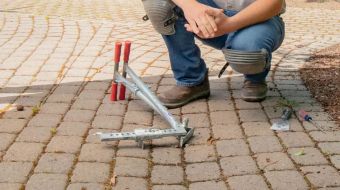
| Component | Problem | Rehabilitation Tasks |
|---|---|---|
| Pavement Surface | Major cracks, spalling or raveling of the porous asphalt or pervious concrete surface |
|
| Paver or grid unit is missing, damaged or displaced |
| |
| Surface infiltration rate is < 250 mm/h |
| |
| Vegetation |
Poor grass cover on interlocking permeable grid system |
|
| Sub-drain |
Sub-drain perforated pipe is obstructed by sediment. |
|
Inspection Time Commitments and Costs[edit]
Estimates are based on a typical partial infiltration permeable pavement design (i.e., includes a sub-drain); estimates for other designs (i.e., full infiltration and no-infiltration) are described in
the Low Impact Development (LID) Stormwater Management Practice Inspection and Maintenance Guide
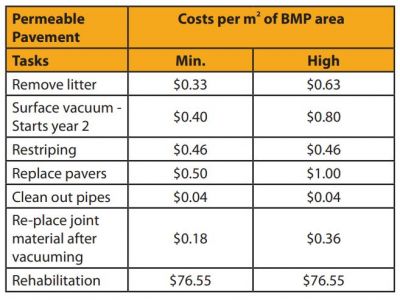
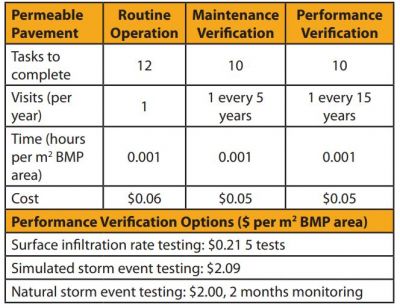
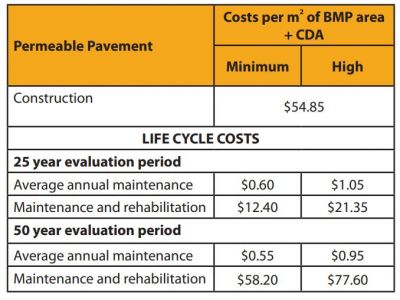
Estimates of the life cycle costs of inspection and maintenance have been produced using the latest version of the LID Life Cycle Costing Tool for three design variations (full infiltration, partial infiltration and no infiltration) to assist stormwater infrastructure planners, designers and asset managers with planning and preparing budgets for potential LID features.
Assumptions for the above costs and the following table below are based on the following:
- Design variations for permeable pavements can be broken down into three main categories:
- Full Infiltration design, where the pavement drains through infiltration into the underlying subsoil alone (i.e., no sub-drain);
- Partial Infiltration design, where drainage is through the combination of a subdrain and infiltration into the underlying subsoil (i.e., with a sub-drain); or,
- No Infiltration (i.e., filtration only design) that includes an impermeable liner between the base of the BMP and the underlying native sub-soil, where drainage is through a sub-drain alone (i.e., with a sub-drain and impermeable liner).
- For permeable pavements it is assumed that rehabilitation of the pavement surface will be needed once the BMP reaches 30 years of age in order to maintain surface drainage performance at an acceptable level. Included in the rehabilitation costs are (de)mobilization costs, as equipment would not have been present on site.
- Design costs were not included in the rehabilitation as it was assumed that the original LID practice design would be used to inform this work. The annual average maintenance cost does not include rehabilitation costs and therefore represents an average of routine maintenance tasks, as outlined in Table Permeable Pavements: Key Components, Descriptions and Routine I&M Requirements, above. All cost value estimates represent the NPV as the calculation takes into account average annual interest (2%) and discount (3%) rates over the evaluation time periods.
- The costing presented in this section is specific to permeable interlocking concrete pavers (PICP), as defined in the Tool. This product has been selected for costing due to its popularity and well understood maintenance needs.
- For all permeable pavement design variations, the CDA has been defined as 2,000 m2 of which 1,000 m2 is impermeable pavement draining to the pavers, and 1,000 m2 is permeable pavement. The impervious area to pervious area ratio (I:P ratio) used to size the BMP footprint is 1:1, which is in accordance with recommendations in the LID SWM Planning and Design Guide (CVC & TRCA, 2010).
- The Full Infiltration design does not include a sub-drain and assumes a native sub-soil infiltration rate of 20 mm/h. The base granular reservoir is 350 mm deep and is capable of storing runoff from a 61 mm rain event over the CDA. A monitoring well is included for inspection purposes.
- The Partial Infiltration design includes a sub-drain and assumes a native sub-soil infiltration rate of 10 mm/h. The base granular reservoir is 350 mm deep and is capable of storing runoff from a 9 mm rain event before the stored volume reaches the perforated underdrain pipe located 50 mm above the native sub-soil. Although a flow restrictor is recommended to maximize infiltration, the cost of this feature is not included due to its relatively low cost.
- The No Infiltration design includes a sub-drain pipe installed on the bottom of the sub-surface water storage reservoir and an impermeable liner. All other features are the same as the Partial Infiltration design variation.
- Estimates of the life cycle costs of PICP permeable pavements in Canadian dollars per unit CDA ($/m2) are presented in the table below. LID Life Cycle Costing Tool allows users to select what BMP type and design variation applies, and to use the default assumptions to generate planning level cost estimates.
- Users can also input their own values relating to a site or area, design, unit costs, and inspection and maintenance task frequencies to generate customized cost estimates, specific to a certain project, context or stormwater infrastructure program.
- For all BMP design variations and maintenance scenarios, it is assumed that rehabilitation of the pavement surface will be necessary when the BMP reaches 30 years of age to maintain acceptable surface drainage performance. Rehabilitation of PICP pavements is assumed to typically involve the following tasks and associated costs:
- Remove pavers, bedding and joint fill and top 5 cm (2”) of base aggregate and replace with new material that meets design specifications
- Construction and Assumption inspection and testing associated with rehabilitation work to confirm that materials meet design specifications and installation is acceptable, including compaction and surface infiltration rate testing.
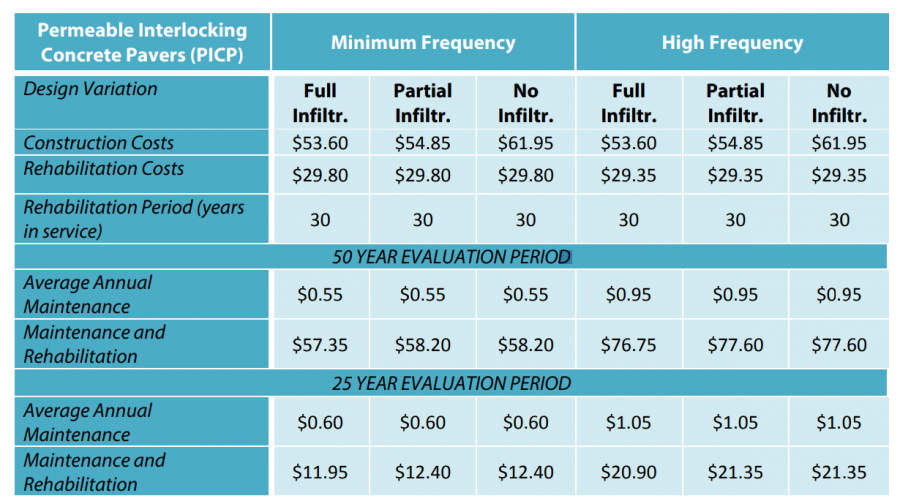
Notes:
- Estimated life cycle costs represent NPV of associated costs in Canadian dollars per square metre of CDA ($/m2).
- Average annual maintenance cost estimates represent NPV of all costs incurred over the time period and do not include rehabilitation costs.
- Rehabilitation cost estimates represent NPV of all costs related to rehabilitative maintenance work assumed to be needed after 30 years in service, including those associated with inspection.
- Full Infiltration design life cycle costs are lower than Partial and No Infiltration designs due to the absence of a sub-drain to construct, inspect and routinely flush.
- Rehabilitation costs for Full Infiltration designs are estimated to be 54.8% to 55.6% of the original construction costs for High and Minimum Recommended Frequency maintenance program scenarios, respectively.
- Rehabilitation costs for Partial Infiltration designs are estimated to be 53.5% to 54.3% of the original construction costs for High and Minimum Recommended Frequency maintenance program scenarios, respectively.
- Rehabilitation costs for No Infiltration designs are estimated to be 47.4% to 48.1% of the original construction costs for High and Minimum Recommended Frequency maintenance program scenarios, respectively.
- Maintenance and rehabilitation costs over a 25 year time period for the Minimum Recommended maintenance scenario are estimated to be 22.3%, of the original construction costs for Full Infiltration design, 22.6% for Partial Infiltration design, and 20.0% for No Infiltration design.
- Maintenance and rehabilitation costs over a 25 year time period for the High Frequency maintenance scenario are estimated to be: 39.0% of the original construction costs for Full, 38.9% for Partial Infiltration designs, and 34.5% for No Infiltration designs.
- Maintenance and rehabilitation costs over a 50 year time period for the Minimum Recommended Frequency maintenance scenario are estimated to be approximately: 1.07 times the original construction cost for Full, 1.06 times the original construction costs for Partial Infiltration designs, and 93.9.% the original construction cost for No Infiltration designs.
- Maintenance and rehabilitation costs over a 50 year time period for the High Frequency maintenance scenario are estimated to be approximately: 1.43 times the original construction cost for Full, 1.41 times the original construction costs for Partial Infiltration designs, and 1.25 times the original construction cost for No Infiltration designs.
Inspection Field Data Sheet[edit]
Feel free to download (downward facing arrow on the top righthand side) and print (Pinter emoticon on top right hand side) the following Permeable pavements Inspection Field Data Form developed by TRCA, STEP and its partners for the Low Impact Development Stormwater Management Practice Inspection and Maintenance Guide[11].
The 4 page document prompts users to fill out details previously mentioned above on this page in other sections about various zones associated with [[[Permeable pavements]] features (i.e. CDA, pavement surface, associated control structures, outlets, etc.) and describe why each area is a pass or fail, and if remediate action is required and under what timeframe it would be completed by. Furthermore, the forms prompt the reviewer to determine what type of inspection is being conducted for the feature in question: Construction (C), Routine Operation (RO), Maintenance Verification (MV), or Performance Verification (PV).
References[edit]
- ↑ TRCA. 2016. Fact Sheet - Inspection and Maintenance of Stormwater Best Management Practices: Permeable Pavement. https://sustainabletechnologies.ca/app/uploads/2018/02/Permeable-Pavement-Fact-Sheet.pdf
- ↑ STEP. 2018. Fact Sheet - Inspection and Maintenance of Stormwater Best Management Practices: Permeable Pavements. https://sustainabletechnologies.ca/app/uploads/2018/02/Permeable-Pavement-Fact-Sheet.pdf
- ↑ Guertin, M. 2010. Simple Screen Gutter Guards Better Than Pro-Installed Systems (and way cheaper). Fine Homebuilding - The Daily Fix. Accessed July 17 2022. https://www.finehomebuilding.com/2010/08/17/simple-screen-gutter-guards-better-than-pro-installed-systems-and-way-cheaper
- ↑ My Gutter Pro. 2021. Clogged Downspout : Causes and Solutions. 10 April 2021. Accessed July 19 2022. https://mygutterpro.com/downspout-clog/
- ↑ Fairfax County. 2014. Protecting our Environment, one Stormwater Practice at a Time - Permeable Pavements. April 2014. Accessed: July 20 2022. https://www.fairfaxcounty.gov/publicworks/sites/publicworks/files/assets/documents/pdf/factsheets/permeable-pavement.pdf
- ↑ Western Interlock Inc. 2020.How to Remove Pavers and Replace Them. Repair & Maintenance. Authored June 2020. Accessed: 21 July 2022. https://westerninterlock.com/how-to-remove-and-replace-a-paver/
- ↑ TRCA. 2018. Inspection and Maintenance of Stormwater Best Management Practices. Permeable Pavements - Fact Sheet. https://sustainabletechnologies.ca/app/uploads/2018/02/Permeable-Pavement-Fact-Sheet.pdf
- ↑ TRCA. 2018. Inspection and Maintenance of Stormwater Best Management Practices. Permeable Pavements - Fact Sheet. https://sustainabletechnologies.ca/app/uploads/2018/02/Permeable-Pavement-Fact-Sheet.pdf
- ↑ TRCA. 2018. Inspection and Maintenance of Stormwater Best Management Practices. Permeable Pavements- Fact Sheet. https://sustainabletechnologies.ca/app/uploads/2018/02/Permeable-Pavement-Fact-Sheet.pdf
- ↑ TRCA. 2016. Low Impact Development Stormwater Management Practice Inspection and Maintenance Guide. Prepared by the Sustainable Technologies Evaluation Program. Vaughan, Ontario. https://sustainabletechnologies.ca/app/uploads/2016/08/LID-IM-Guide-7.4-Permeable-Pavements.pdf
- ↑ STEP. 2016. Low Impact Development Stormwater Management Practice Inspection and Maintenance Guide. https://sustainabletechnologies.ca/app/uploads/2016/08/LID-IM-Guide-2016-1.pdf
